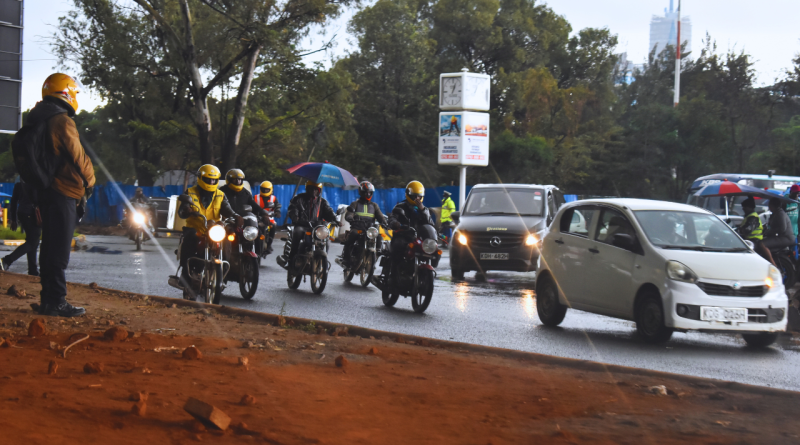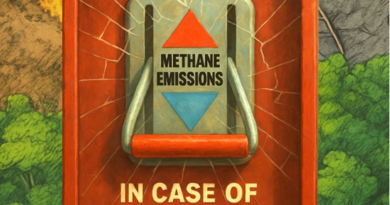From Electric Mobility to Green Solutions for Tackling Nairobi’s Air Pollution
Watch the full documentary on Nairobi’s air pollution crisis and the journey towards cleaner air.
Every evening, Ronald Onyinkwa Matoke parks his boda-boda (motorcycle taxi) just outside a pharmacy in Upperhill, Nairobi — not to pick up painkillers for his clients, but for himself. The pounding headaches that creep in by mid-morning have become routine, and by dusk, his limbs feel heavy.
Matoke is one of more than 176,000 registered motorcycle taxi riders in Nairobi, a fraction of Kenya’s estimated 1.4 million motorcycles. They keep the nation moving — but not without a cost.

Motorbike emissions are among the key contributors to Nairobi’s deteriorating air quality. Experts warn that the pollutants — including carbon monoxide and hydrocarbons — not only degrade the environment but pose an immediate threat to the people breathing them in daily.
“Much like cigarette smoking, inhaling this polluted air over extended periods can result in chronic health conditions,” said Dr. Waweru Munyu, a Nairobi-based pulmonologist. “Short-term effects include sneezing, coughing, chest tightness, and wheezing.”
Dr. Munyu added that prolonged exposure to vehicular emissions raises the risk of chronic obstructive pulmonary disease (COPD), cardiovascular problems, stroke, and even cancer.

“People living near high-traffic areas — including boda-boda riders, drivers, and mechanics — face elevated risks of lung infections and asthma due to constant exposure to vehicular emissions,” said Dr. Munyu.
The toll is stark: Nairobi records approximately 28,000 air pollution-related deaths annually, including over 1,000 premature deaths within the city, according to Dr. George Mwaniki, Head of Air Quality at the World Resources Institute (WRI) Africa.
The World Resources Institute (WRI), through its flagship Clean Air Catalyst program, identifies vehicular emissions as the largest contributors to air pollution in Nairobi.

“Air pollution in Nairobi has worsened by 180 times since independence in 1963 — a staggering increase that far surpasses trends in neighboring cities like Kampala,” Mwaniki said.
Nairobi’s Air Quality Monitoring Analysis
Dr. John Birir, a researcher at the University of Nairobi’s Institute of Nuclear Science and Technology, observes notable fluctuations in air pollution between day and night.
“Pollution peaks during rush hours when traffic congestion is highest, then drops slightly at night,” he said. “But even nighttime levels in many areas remain above recommended safety thresholds.”

Dr. Birir is particularly concerned about fine particulate matter, especially PM2.5 — microscopic particles over 30 times thinner than a human hair that pose serious health risks when inhaled.
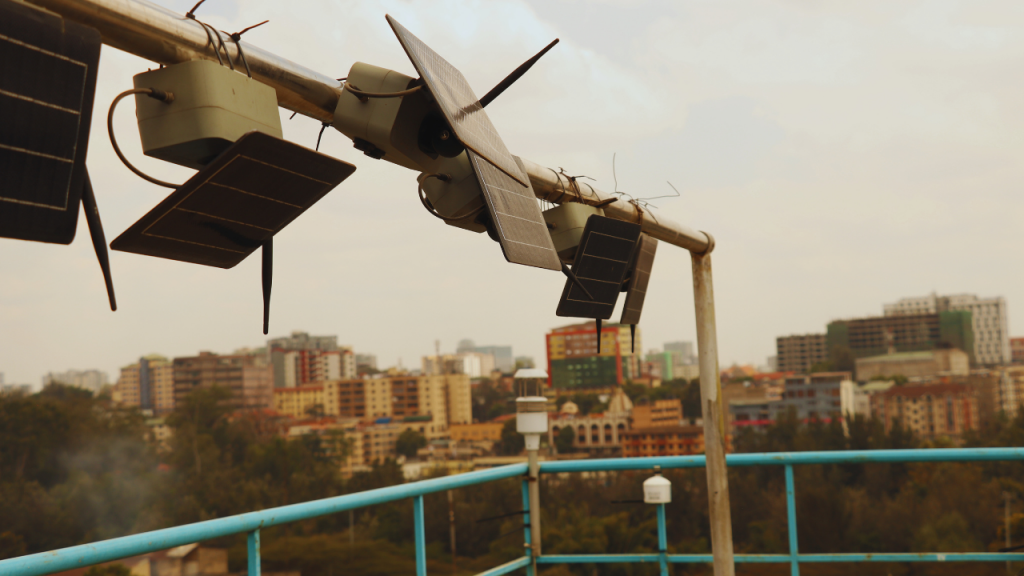
Nairobi’s PM2.5 concentrations are well above the World Health Organization’s recommended annual limit of 5 micrograms per cubic meter, raising deep public health concerns.
“When we breathe in these tiny particles, they penetrate deep into the lungs and can even enter the bloodstream — which is extremely harmful,” said Dr. Munyu.
The Global South State Concerns:
The World Bank notes that people in low- and middle-income countries bear the brunt of air pollution-related illnesses and deaths.
“The death rate associated with air pollution is significantly higher in low- and lower-middle-income countries than in high-income countries,” the institution reports.
According to a 2022 World Bank report, the global cost of health damages associated with exposure to air pollution is $8.1 trillion, equivalent to 6.1 percent of global GDP.
Anumita Roychowdhury, Executive Director of the Center for Science and Environment (CSE) in India, draws parallels between Nairobi and other rapidly urbanizing cities in the Global South.
“When I came to Nairobi, what struck me was the shared challenge we face,” she said. “I’m from India, and I know firsthand what an air pollution crisis looks like.”
Speaking during the launch of the State of Africa’s Environment Report 2023, Roychowdhury noted that while Africa has lower rates of vehicle ownership than other regions, the number of vehicles is rising rapidly.
“About 80 to 90 percent of vehicles in this region are old and poorly maintained,” she said. “That’s a major driver of emissions.”

Roychowdhury also highlighted research findings showing that 14% of all deaths among children under the age of five across Africa are linked to air pollution.
The report underscores the long-term consequences of early exposure, noting: “The impact on newborns and infants also has long-term consequences for overall health, including issues with lung development and increased susceptibility to communicable diseases such as lower respiratory infections in young children.”
Jane Akumu, Africa focal point at the UN Environment Programme (UNEP), points to one of the region’s persistent challenges: Africa’s heavy dependence on imported used vehicles, many of which are outdated and fail to meet emission standards.
“These vehicles often fail to meet modern emission standards and safety requirements, as they are not subject to a stringent age limit,” said Akumu.
She said that outdated engine technology and lack of emissions control systems make these imports significantly more polluting and that urban planning and sustainable mobility remain major challenges for African cities, where rapid growth continues to outpace infrastructure development.
“Importing such vehicles not only worsens air pollution, but also carries economic consequences — including higher maintenance costs and an increased risk of breakdowns — all of which drive up the overall cost of ownership,” she said.

Jane Akumu, Africa Focal at the UN Environment, discussing the challenges and possible solutions of planning and sustainable mobility in African cities, October 13, 2023. Photo/Chemtai Kirui.
The gendered aspect of Air pollution:
Dr. Munyu emphasized the occupational risks of air pollution, saying:
“Certain careers — such as those in the transport industry, dusty factories, or garages — where men are more commonly employed, can lead to long-term lung conditions due to exposure to airborne substances without proper protection.”
While men are often exposed to high levels of pollution due to their work environments, Dr. Munyu also added that:
“Air pollution exerts a disproportionate toll on women, especially those in their childbearing years.”
A study published by National library of Science, supports this, indicating that air pollution is a serious risk factor for pregnant women and newborns, particularly in urban areas with heavy traffic-related pollutants. The study warned of potential health consequences such as low birth weight, respiratory illnesses, and even premature death.
“We have to understand the special vulnerability of some sections of the population — particularly women, children, and the elderly,” said Roychowdhury.
She spoke of the double burden faced by women and children in the Global South:
“They are not only inhaling polluted air outdoors but also indoors, where many still cook using solid fuels on open stoves. The smoke fills up their homes.”
E-mobility as part of the solution
As the urgency to address Nairobi’s air pollution crisis grows, the city is slowly embracing electric mobility (E-mobility) as a potential game-changer.
E-mobility — which includes electric vehicles (EVs), e-bikes, and electric motorcycles — is emerging as a promising solution to reduce vehicular emissions and improve air quality, especially in high-traffic areas.

An electric motorcycle glides on silently Nairobi’s road, September 27, 2023. Photo/Chemtai Kirui.
Numerous initiatives in Nairobi — and across the continent — are actively working to accelerate the transition to electric vehicles and sustainable transportation options.
Celeste Tchetgen Vogel, CEO and Co-Founder of eWAKA, a Nairobi-based e-mobility company, envisions electric mobility as a game-changer for Africa.
“Electric mobility can be for Africa what the smartphone was for Africa,” she said. “It has the potential to transform the way we live, do business, and move within our cities.”
Vogel stressed the urgent need to act on air pollution, not just as an environmental issue, but as a public health crisis.
“It’s a health issue, and people are losing their lives because of it,” she added.

CEO and Co-Founder of eWAKA, Celeste Tchetgen Vogel, navigating Nairobi’s Ngong Road on an electric bike, September 26, 2023. Photo/Chemtai Kirui.
Alongside the urgent need to reduce air pollution, Vogel also underscores the broader economic potential of electric mobility, including job creation and new business opportunities.
Highlighting Kenya’s growing interest in e-mobility, she notes that the country’s curiosity and early adoption efforts have positioned it as a regional leader in the industry.
“Curiosity is an important factor in promoting sustainable transportation,” she said.
However, Vogel points out a critical challenge facing the sector — battery performance.
“There’s an obsession with range — how far can the e-bike go before it shuts down,” she said.
She urges a shift in focus toward developing public charging infrastructure and adopting a long-term, well-planned approach to supporting electric mobility.
Kennedy Mutava, lead mechanical engineer at Kiri EV Limited, a Nairobi-based e-mobility company, highlights two main charging models currently in use: battery swapping and battery ownership.
He said that understanding these models is key for consumers and businesses to make informed decisions based on their specific needs.
“Each approach has its advantages,” said Mutava. “But what matters most is creating a system that’s reliable, scalable, and accessible to everyday riders.”

Lead Mechanical Engineer at Kiri EV Limited, Kennedy Mutava, showcasing the future of mobility on his electric motorcycle in Nairobi, September 27, 2023. Photo/Chemtai Kirui.
“Electric mobility is not only an eco-friendly solution but also a cost-effective mode of transport,” said Mutava. “It contributes to societal benefits by making life more affordable and healthier. Charging an electric motorbike at home is cheaper than operating a petrol bike over the same distance.”
Akumu echoed Mutava’s affordability sentiments, adding on the practicality of electric vehicles, particularly in countries with irregular power supply.
“Electric vehicles can be charged at night, when there’s excess electricity and lower demand,” she said.
At the Africa Climate Summit 2023, the Kenyan government reaffirmed its commitment to accelerating e-mobility adoption as part of its strategy to cut greenhouse gas emissions.
President William Ruto declared:
“The adoption of electric mobility is a high-priority intervention to address the challenges of pollution, adverse health effects, and fuel costs.”
E-mobility remains central in Kenya’s National Climate Change Action Plan, aligning with the country’s Nationally Determined Contribution (NDC) target of reducing greenhouse gas emissions by 32% by 2030.
A report by the Energy and Petroleum Regulatory Authority (EPRA) estimates that the transport sector contributes approximately 13% of Kenya’s total emissions, underscoring the urgency of transitioning to cleaner, healthier transport solutions — notably electric vehicles.
Experts stress that addressing urban air pollution will require a multi-faceted approach, combining policy, infrastructure, public education, and innovative technologies.
Karura as a nature-based solution: Karura as a nature-based solution:
On a quiet stretch deep within Karura Forest, surrounded by towering trees and the gentle chorus of birdsong, Peter Njui, Operations Manager at Friends of Karura — a Community Forest Association — directs a ranger perched on an electric motorcycle.
To a casual observer, it may seem like just another two-wheeler, but as it glides away with no engine roar or kickstart struggle, it’s clear: this is clean transport in motion.

A ranger from Friends of Karura Community Forests Association patrols on an electric bike in Karura Forest, November 8, 2023. Photo/Chemtai Kirui.
Amid the rhythmic sway of trees and the soothing hush of a rainy afternoon, it’s easy to forget that Karura Forest lies at the heart of one of Africa’s busiest cities. Spanning over 1,000 acres, Karura is more than a recreational space — it’s a vital nature-based solution, home to diverse indigenous plants that filter pollutants and contribute carbon sequestration.

Towering trees stand tall in the heart of Karura Forest, October 31, 2023. Photo/Chemtai Kirui.
“We abstain from using motorized or petrol/diesel machines in the forest to prevent increased carbon emissions,” said Njui, who noted that, “For visitors to Karura Forest, we encourage carpooling to minimize the number of vehicles and emissions within the forest.”
James Mwang’ombe Mwamodenyi, Principal Conservator of Forests and Head of Biodiversity at the Kenya Forest Service (KFS), credited Karura’s preservation to the strong partnership between the government and local communities.
“Community-led initiatives play a key role in clearing invasive species and planting indigenous trees — which strengthens the forest’s ability to clean the air,” he said.
But Karura’s clean air doesn’t just come from trees. Its moss-covered trunks play a quiet but crucial role.
“In Karura, moss growing on trees helps trap particles from the air, making the surrounding air fresher for nearby residents,” Mwamodenyi noted.
Moss, though small and non-flowering, is remarkably effective at trapping airborne pollutants. It lacks a vascular system, but its dense surface acts like a natural sponge — filtering particles from the air and improving environmental quality. Still, nature has its limits.
“Despite biodiversity’s powerful role in capturing pollutants, excessive emissions can overwhelm these systems and reduce their effectiveness,” Mwamodenyi said.
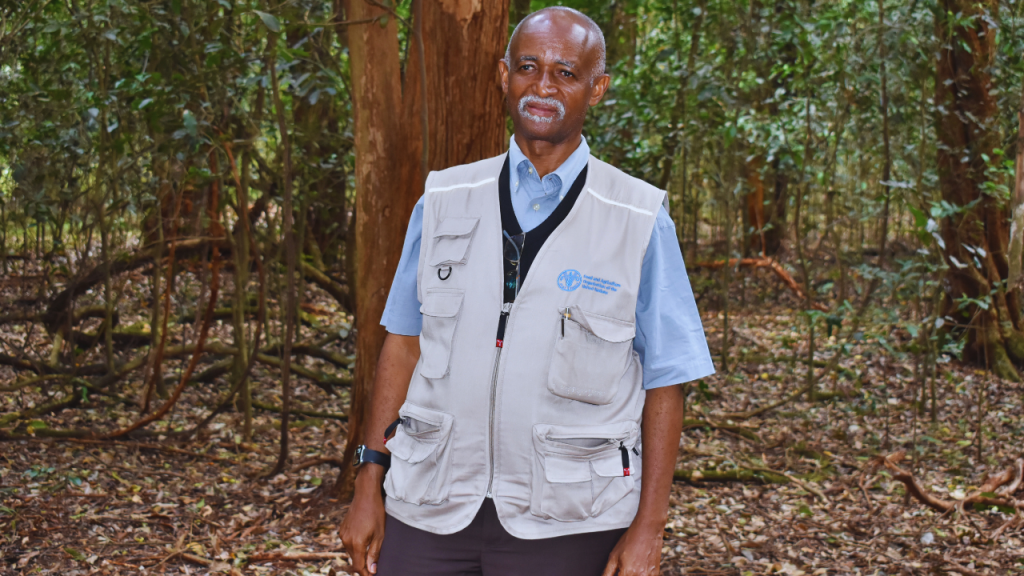
James Mwang’ombe Mwamodenyi, Principal Conservator of Forests and Head of Biodiversity at Kenya Forest Service (KFS), surrounded by the lush indigenous trees of Karura Forest during an interview on October 31, 2023. Photo/Chemtai Kirui.
To keep the forest resilient, the Kenya Forest Service carries out continuous tree planting sessions, while rangers use electric motorbikes to monitor and protect the forest — reinforcing their commitment to zero-emission practices.
“We champion the use of non-carbon-emitting motorcycles and vehicles to set an example,” Njui said.
“Our goal is to preserve the health of the forest while promoting environmentally responsible behavior.”
But conservation in Karura is not just about trees and technology. The local community — especially women — plays a vital role in its sustainability. Women have taken the lead in cultivating tree nurseries, growing indigenous seedlings used for reforestation and sold to earn an income.
This blend of climate action, community stewardship, and clean innovation shows what’s possible when cities invest in both nature and people — and when forests like Karura are allowed to breathe, protect, and inspire.
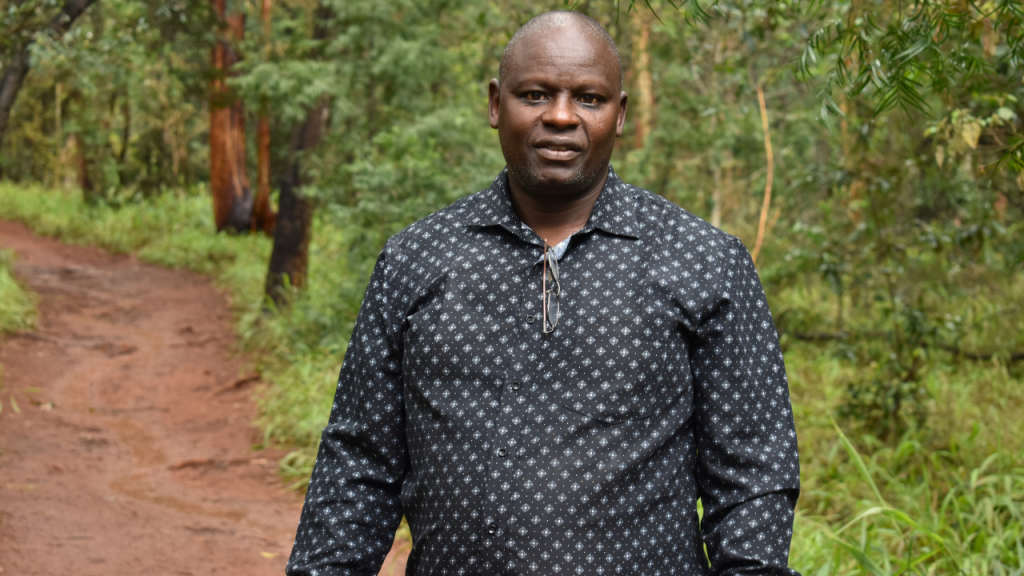
Peter Njui, Operational Manager of The Friends of Karura, a Community Forest Association, at Karura Forest, November 8, 2023. Photo/Chemtai Kirui.
Taking control now
While experts acknowledge the complexities of curbing air pollution in cities already grappling with poor air quality, they agree that immediate and actionable steps can still make a significant difference.
Dr. Mwaniki, sees enormous potential in e-mobility.
“E-mobility is one area with great promise to reduce air pollution in the country because around 95% of our electricity comes from cleaner sources,” he said.
He emphasized the urgent need for a Clean Air Action Plan — one that outlines clear mitigation strategies for various sources of pollution and ensures proper infrastructure, enforcement, and implementation.
For Matoke, and thousands of riders like him, the shift to cleaner transport is not just an environmental imperative — it’s a potential lifeline for their health, livelihoods, and the future of Nairobi’s air.
“We need a Clean Air Act that defines roles for national and county governments, sets specific air quality goals, and introduces incentives for industries and individuals to adopt cleaner technologies,” he said.
Mamo Boru Mamo, Director General of the National Environment Management Authority (NEMA), revealed that the government is preparing to enforce mandatory emission testing for vehicles in Kenya.
“Nineteen testing centers have already been mapped out,” he said. “We hope to begin implementation by January or February. Compliance will be indicated through NEMA-issued stickers.”
Akumu, on the other end said that that policy must go hand in hand with local manufacturing and infrastructure investment.
“The key to incentivizing a shift to electric transport lies in building the manufacturing sector,” she said.
“By investing in local EV production and charging networks, we create jobs and develop a skilled workforce — boosting both economic resilience and environmental conservation.”
Back on the ground in Nairobi, Ronald Onyinkwa Matoke is open to the idea — if it’s accessible and clearly explained.
“I’m open to change,” he said. “If someone showed us where to get electric bikes and how much they cost, I would seriously consider switching. I’ve heard you can charge the battery for just Ksh.100 a day — that’s promising.”
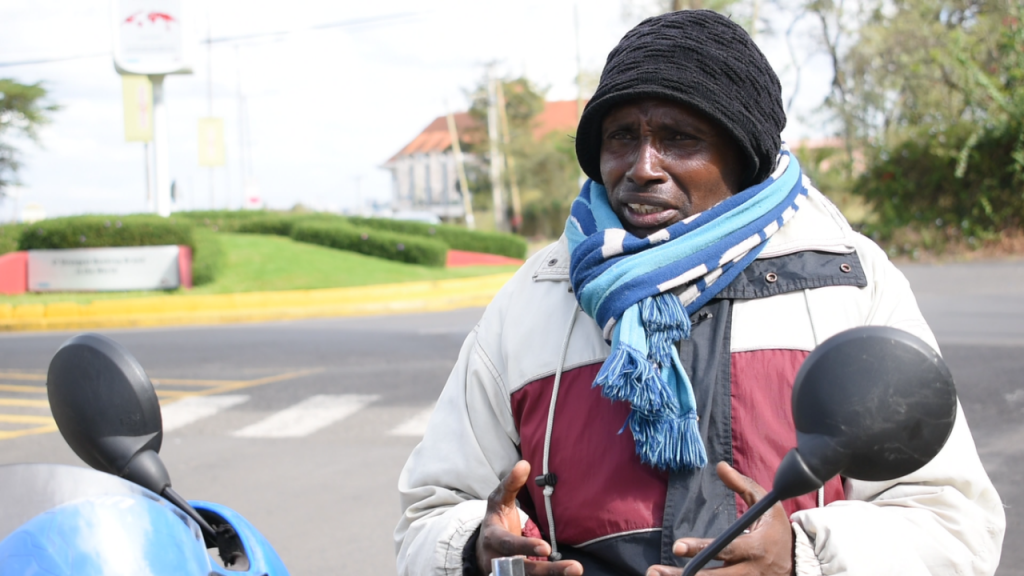
Ronald Onyikwa Matoke, a boda-boda rider in Nairobi, pictured during an interview on October 19, 2023. Photo/Chemtai Kirui.
For Matoke, and thousands of riders like him, the shift to cleaner transport is not just an environmental imperative — it’s a potential lifeline for their health, livelihoods, and the future of Nairobi’s air.

